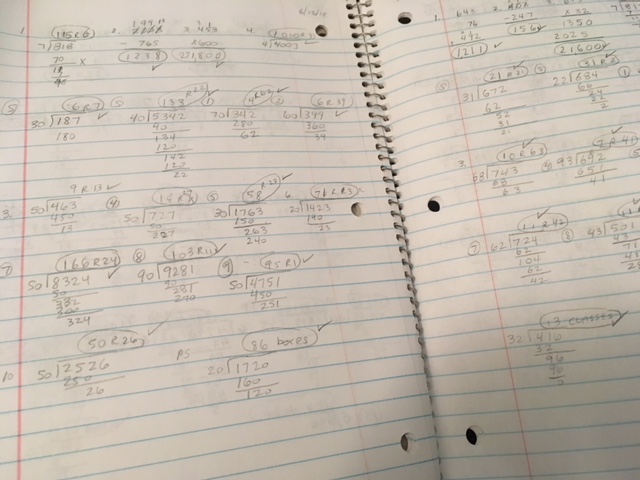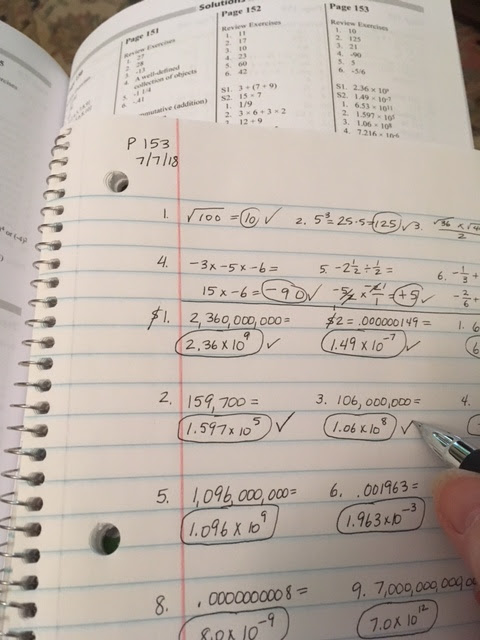In June I learned I would be reviewing Math Refresher for Adults,
a book in the Math Essentials series, by Rick Fisher.
When I initially signed up asking for this review, I wasn't sure if the student would be myself or my son, who is starting college in the fall. As it turns out, the college offered my son a free on-line remedial math course, so I have been the student.
The first thing I did, after reading the introduction, was find myself a fresh new spiral notebook to do my math work. Pages in the book have space for answers to be written down, but I prefer not to do that.
After getting myself a spiral notebook, I got out a storage box of sharpened pencils to keep by my side whenever I was doing my Math. Then I looked through the available topics in the three page Table of Contents.
I need to tell you though, in the spirit of full disclosure, that I love Math. I love doing Math. So initially I just sat down and worked through the entire first section, one lesson at a time.
The answers are at the back of the book, so you do a lesson, check a lesson. I am also an editor by nature. I kept looking for errors in the answer key. Oh, I found errors... but they were MY errors. ::sigh:: If I worked too fast 8 + 6 would come up as 12, or I'd miss a negative sign and get the answer wrong.
When I finished section 1, I decided to skip to the back of the book (pre-Algebra/Algebra) where my son would work if he were in this book. I immediately got a "review" question I couldn't answer about the area or circumference of a circle. So I dropped back in the book again to work where I really did need review.
One section where I got the answer wrong was an area question (#5 below):
So as I looked at the problem, I saw a square figure with a side measuring 4-1/2 ft. So I multiplied 4-1/2 X 4-1/2, and I got the answer wrong. The shape is actually a rectangle, and I did not see that one side measures 1-1/2 ft. The reason I mention this is that if I had a student working through this book who did that, with me checking the answers, I wouldn't want to just hand the paper back to the student with a red X next to the answer to #5. If your student gets something wrong, look at it and see if it was a minor mistake. The goal is for the student to be learning, reviewing, filling in gaps.
The better method is to have the student check each lesson's answers himself. It is really easy using the spiral notebook method -- just turn to the back of the book and hold the spiral up to the answer key page and go through the problems one by one. I like the answer circled so it is easy to find the answer to check it.
So, as I said, after initially doing all of the first section (basic addition, subtraction, multiplication, division) I skipped around and worked on topics I needed review on. These included formulas (area of a circle, circumference of a circle) and scientific notation. I don't know why, but for me the presentation in this book for scientific notation really made it click for the first time. I feel really confident about working these problems now, and I never did before.
The way this textbook works is as follows:
- First, decide on a lesson to work on based on the topic you need to review. The Contents has the subjects divided into these sections: Whole Numbers, Fractions, Decimals, Percents, Geometry, Integers, Charts and Graphs, Word Problems, and Pre-Algebra and Algebra. Within each section, each lesson describes what it focuses on, such as "Circles" in Geometry, or "Square Roots" or "Scientific Notation" in Pre-Algebra and Algebra.
- Within the lesson you decide to focus on, it will start with "Review Exercises". If you aren't ready for the Review Exercises on that lesson (like I didn't know how to do circumference of a circle) you want to skip back further in the book and understand the "review" topic before doing the lesson you originally had picked.
- Following the "Review Exercises" in each lesson is a "Helpful Hints" section. This is a reminder of the information you will need to do the rest of the problems in the lesson. If these hints are not enough, you will want to dive into the video component that is available, that I will address below.
- Each lesson ends with "Problem Solving", which is a little word problem related to the rest of the lesson. Sometimes I just didn't even see these word problems, like my eyes glazed over. When I am in number mode, I sometimes do not want to read words.
- Mastering Essential Math Skills, Book 1;
- Mastering Essential Math Skills, Book 2;
- Pre-Algebra Concepts; and
- No-Nonsense Algebra
Richard Fisher is committed to math literacy in students and adults. His Math Refresher for Adults, with its access to all the other math programs, is something he is making available because he wants to do all that he can to help others succeed in math. It is a wonderful program!
So I have thoroughly enjoyed my time working through my math review using Math Refresher for Adults. My son has not been as successful in his college math review, so I am going to offer this text to him to use, if he wishes, instead of using the college-provided review course. I highly recommend this course to you.
Consider this course if you are preparing to teach your students and are rusty. Consider this course if your student might have gaps in his learning and you want to fill them in. Consider this course if your student seems advanced and you want to see if they are ready for the next level. Consider this course if your student is preparing for the ACT, the SAT, or the Math Accuplacer, or your student is graduating and preparing to take a college math readiness test. It is a great course.
To see what other members of the Schoolhouse Review Crew thought of Math Refresher for Adults, click on the link below to read their reviews.













No comments :
Post a Comment